
Rings of Uranus
Encyclopedia
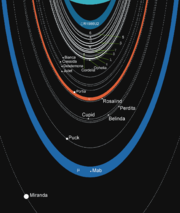
Uranus
Uranus is the seventh planet from the Sun. It has the third-largest planetary radius and fourth-largest planetary mass in the Solar System. It is named after the ancient Greek deity of the sky Uranus , the father of Cronus and grandfather of Zeus...
has a system of ring
Planetary ring
A planetary ring is a ring of cosmic dust and other small particles orbiting around a planet in a flat disc-shaped region.The most notable planetary rings known in Earth's solar system are those around Saturn, but the other three gas giants of the solar system possess ring systems of their...
s intermediate in complexity between the more extensive set around Saturn
Rings of Saturn
The rings of Saturn are the most extensive planetary ring system of any planet in the Solar System. They consist of countless small particles, ranging in size from micrometres to metres, that form clumps that in turn orbit about Saturn...
and the simpler systems around Jupiter
Rings of Jupiter
The planet Jupiter has a system of rings, known as the rings of Jupiter or the Jovian ring system. It was the third ring system to be discovered in the Solar System, after those of Saturn and Uranus. It was first observed in 1979 by the Voyager 1 space probe and thoroughly investigated in the 1990s...
and Neptune
Rings of Neptune
The rings of Neptune consist primarily of five principal rings predicted in 1984 by André Brahic and imaged in 1989 by the Voyager 2 spacecraft...
. The rings of Uranus were discovered on March 10, 1977, by James L. Elliot
James L. Elliot
James Ludlow Elliot was an American astronomer and scientist who, as part of a team, discovered the rings around the planet Uranus. Elliot was also part of a team that observed global warming on Triton, the largest moon of Neptune....
, Edward W. Dunham, and Douglas J. Mink
Douglas J. Mink
Douglas J. Mink is an American software developer and a data archivist at the Harvard-Smithsonian Center for Astrophysics. Mink was part of the team that discovered the rings around the planet Uranus....
. More than 200 years ago, William Herschel
William Herschel
Sir Frederick William Herschel, KH, FRS, German: Friedrich Wilhelm Herschel was a German-born British astronomer, technical expert, and composer. Born in Hanover, Wilhelm first followed his father into the Military Band of Hanover, but emigrated to Britain at age 19...
also reported observing rings, but modern astronomers are skeptical that he could have actually seen them, as they are very dark and faint. Two additional rings were discovered in 1986 in images taken by the Voyager 2
Voyager 2
The Voyager 2 spacecraft is a 722-kilogram space probe launched by NASA on August 20, 1977 to study the outer Solar System and eventually interstellar space...
spacecraft, and two outer rings were found in 2003–2005 in Hubble Space Telescope
Hubble Space Telescope
The Hubble Space Telescope is a space telescope that was carried into orbit by a Space Shuttle in 1990 and remains in operation. A 2.4 meter aperture telescope in low Earth orbit, Hubble's four main instruments observe in the near ultraviolet, visible, and near infrared...
photos.
the Uranian ring system is known to consist of 13 distinct rings. In the order of increasing distance from the planet they are designated 1986U2R/ζ, 6, 5, 4, α, β, η, γ, δ, λ, ε, ν and μ. Their radii range from about 38,000 km for the 1986U2R/ζ ring to about 98,000 km for the μ ring. Additional faint dust bands and incomplete arcs may exist between the main rings. The rings are extremely dark—the Bond albedo
Bond albedo
The Bond albedo, named after the American astronomer George Phillips Bond , who originally proposed it, is the fraction of power in the total electromagnetic radiation incident on an astronomical body that is scattered back out into space...
of the rings' particles does not exceed 2%. They are probably composed of water ice with the addition of some dark radiation-processed organics
Organic compound
An organic compound is any member of a large class of gaseous, liquid, or solid chemical compounds whose molecules contain carbon. For historical reasons discussed below, a few types of carbon-containing compounds such as carbides, carbonates, simple oxides of carbon, and cyanides, as well as the...
.
The majority of Uranus's rings are opaque and only a few kilometers wide. The ring system contains little dust overall; it consists mostly of large bodies 0.2–20 m in diameter. However, some rings are optically thin: the broad and faint 1986U2R/ζ, μ and ν rings are made of small dust particles, while the narrow and faint λ ring also contains larger bodies. The relative lack of dust in the ring system is due to aerodynamic drag from the extended Uranian exosphere
Exosphere
The exosphere is the uppermost layer of Earth's atmosphere. In the exosphere, an upward travelling molecule moving fast enough to attain escape velocity can escape to space with a low chance of collisions; if it is moving below escape velocity it will be prevented from escaping from the celestial...
—corona.
The rings of Uranus are thought to be relatively young, at not more than 600 million years old. The Uranian ring system probably originated from the collisional fragmentation of a number of moons that once existed around the planet. After colliding, the moons probably broke up into numerous particles, which survived as narrow and optically dense rings only in strictly confined zones of maximum stability.
The mechanism that confines the narrow rings is not well understood. Initially it was assumed that every narrow ring had a pair of nearby shepherd moons
Planetary ring
A planetary ring is a ring of cosmic dust and other small particles orbiting around a planet in a flat disc-shaped region.The most notable planetary rings known in Earth's solar system are those around Saturn, but the other three gas giants of the solar system possess ring systems of their...
corralling them into shape. However, in 1986 Voyager 2 discovered only one such shepherd pair (Cordelia
Cordelia (moon)
Cordelia is the innermost moon of Uranus. It was discovered from the images taken by Voyager 2 on January 20, 1986, and was given the temporary designation S/1986 U 7. It was not detected again until the Hubble Space Telescope observed it in 1997...
and Ophelia
Ophelia (moon)
Ophelia is a moon of Uranus. It was discovered from the images taken by Voyager 2 on January 20, 1986, and was given the temporary designation S/1986 U 8. It was not seen until the Hubble Space Telescope recovered it in 2003. Ophelia was named after the daughter of Polonius, Ophelia, in...
) around the brightest ring (ε).
Discovery
The first mention of a Uranian ring system comes from William Herschel's notes detailing his observations of Uranus in the 18th century, which include the following passage: "February 22, 1789: A ring was suspected". Herschel drew a small diagram of the ring and noted that it was "a little inclined to the red". The Keck Telescope in Hawaii has since confirmed this to be the case, at least for the ν ring. Herschel's notes were published in a Royal SocietyRoyal Society
The Royal Society of London for Improving Natural Knowledge, known simply as the Royal Society, is a learned society for science, and is possibly the oldest such society in existence. Founded in November 1660, it was granted a Royal Charter by King Charles II as the "Royal Society of London"...
journal in 1797. However, in the two centuries between 1797 and 1977 the rings are rarely mentioned, if at all. This casts serious doubt on whether Herschel could have seen anything of the sort while hundreds of other astronomers saw nothing. Still, it has been claimed by some that Herschel gave accurate descriptions of the ν ring's size relative to Uranus, its changes as Uranus travelled around the Sun, and its color.
The definitive discovery of the Uranian Rings was made by astronomers James L. Elliot
James L. Elliot
James Ludlow Elliot was an American astronomer and scientist who, as part of a team, discovered the rings around the planet Uranus. Elliot was also part of a team that observed global warming on Triton, the largest moon of Neptune....
, Edward W. Dunham, and Douglas J. Mink
Douglas J. Mink
Douglas J. Mink is an American software developer and a data archivist at the Harvard-Smithsonian Center for Astrophysics. Mink was part of the team that discovered the rings around the planet Uranus....
on March 10, 1977, using the Kuiper Airborne Observatory
Kuiper Airborne Observatory
The Gerard P. Kuiper Airborne Observatory was a national facility operated by NASA to support research in infrared astronomy. The observation platform was a highly modified C-141A jet transport aircraft with a range of 6,000 nautical miles , capable of conducting research operations up to 48,000...
, and was serendipitous
Serendipity
Serendipity means a "happy accident" or "pleasant surprise"; specifically, the accident of finding something good or useful without looking for it. The word has been voted as one of the ten English words hardest to translate in June 2004 by a British translation company. However, due to its...
. They planned to use the occultation
Occultation
An occultation is an event that occurs when one object is hidden by another object that passes between it and the observer. The word is used in astronomy . It can also refer to any situation wherein an object in the foreground blocks from view an object in the background...
of the star SAO 158687 by Uranus to study the planet's atmosphere. However, when their observations were analyzed, they found that the star disappeared briefly from view five times both before and after it was eclipsed by the planet. They deduced that a system of narrow rings was present. The five occultation events they observed were denoted by the Greek letters α, β, γ, δ and ε in their papers. These designations have been used as the rings' names since then. Later they found four additional rings: one between the β and γ rings and three inside the α ring. The former was named the η ring. The latter were dubbed rings 4, 5 and 6—according to the numbering of the occultation events in one paper. Uranus's ring system was the second to be discovered in the Solar System, after that of Saturn
Rings of Saturn
The rings of Saturn are the most extensive planetary ring system of any planet in the Solar System. They consist of countless small particles, ranging in size from micrometres to metres, that form clumps that in turn orbit about Saturn...
.
The rings were directly imaged when the Voyager 2
Voyager 2
The Voyager 2 spacecraft is a 722-kilogram space probe launched by NASA on August 20, 1977 to study the outer Solar System and eventually interstellar space...
spacecraft flew through the Uranian system in 1986. Two more faint rings were revealed, bringing the total to eleven. The Hubble Space Telescope
Hubble Space Telescope
The Hubble Space Telescope is a space telescope that was carried into orbit by a Space Shuttle in 1990 and remains in operation. A 2.4 meter aperture telescope in low Earth orbit, Hubble's four main instruments observe in the near ultraviolet, visible, and near infrared...
detected an additional pair of previously unseen rings in 2003–2005, bringing the total number known to 13. The discovery of these outer rings doubled the known radius of the ring system. Hubble also imaged two small satellites for the first time, one of which, Mab
Mab (moon)
Mab , or Uranus XXVI , is an inner satellite of Uranus. It was discovered by Mark R. Showalter and Jack J. Lissauer in 2003 using the Hubble Space Telescope...
, shares its orbit with the outermost newly discovered ring.
General properties
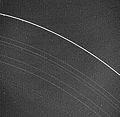
Dust
Dust consists of particles in the atmosphere that arise from various sources such as soil dust lifted up by wind , volcanic eruptions, and pollution...
, although dust is known to be present in 1986U2R/ζ, η, δ, λ, ν and μ rings. In addition to these well-known rings, there may be numerous optically thin dust bands and faint rings between them. These faint rings and dust bands may exist only temporarily or consist of a number of separate arcs, which are sometimes detected during occultation
Occultation
An occultation is an event that occurs when one object is hidden by another object that passes between it and the observer. The word is used in astronomy . It can also refer to any situation wherein an object in the foreground blocks from view an object in the background...
s. Some of them became visible during a series of ring plane-crossing events in 2007. A number of dust bands between the rings were observed in forward-scattering geometry by Voyager 2
Voyager 2
The Voyager 2 spacecraft is a 722-kilogram space probe launched by NASA on August 20, 1977 to study the outer Solar System and eventually interstellar space...
. All rings of Uranus show azimuthal brightness variations.
The rings are made of an extremely dark material. The geometric albedo
Geometric albedo
The geometric albedo of an astronomical body is the ratio of its actual brightness at zero phase angle to that of an idealized flat, fully reflecting, diffusively scattering disk with the same cross-section....
of the ring particles does not exceed 5–6%, while the Bond albedo
Bond albedo
The Bond albedo, named after the American astronomer George Phillips Bond , who originally proposed it, is the fraction of power in the total electromagnetic radiation incident on an astronomical body that is scattered back out into space...
is even lower—about 2%. The rings particles demonstrate a steep opposition surge—an increase of the albedo when the phase angle
Phase angle
In the context of vectors and phasors, the term phase angle refers to the angular component of the polar coordinate representation. The notation A\ang \!\ \theta, for a vector with magnitude A and phase angle θ, is called angle notation.In the context of periodic phenomena, such as a wave,...
is close to zero. This means that their albedo is much lower when they are observed slightly off the opposition. The rings are slightly red in the ultraviolet
Ultraviolet
Ultraviolet light is electromagnetic radiation with a wavelength shorter than that of visible light, but longer than X-rays, in the range 10 nm to 400 nm, and energies from 3 eV to 124 eV...
and visible parts of the spectrum
Spectrum
A spectrum is a condition that is not limited to a specific set of values but can vary infinitely within a continuum. The word saw its first scientific use within the field of optics to describe the rainbow of colors in visible light when separated using a prism; it has since been applied by...
and grey in near-infrared. They exhibit no identifiable spectral feature
Spectrum analysis
Spectrum, also known as emission spectrochemical analysis, is the original scientific method of charting and analyzing the chemical properties of matter and gases by looking at the bands in their optical spectrum...
s. The chemical composition of the ring particles is not known. However, they cannot be made of pure water ice like the rings of Saturn
Rings of Saturn
The rings of Saturn are the most extensive planetary ring system of any planet in the Solar System. They consist of countless small particles, ranging in size from micrometres to metres, that form clumps that in turn orbit about Saturn...
because they are too dark, darker than the inner moons of Uranus. This indicates that they are probably composed of a mixture of the ice and a dark material. The nature of this material is not clear, but it may be organic compound
Organic compound
An organic compound is any member of a large class of gaseous, liquid, or solid chemical compounds whose molecules contain carbon. For historical reasons discussed below, a few types of carbon-containing compounds such as carbides, carbonates, simple oxides of carbon, and cyanides, as well as the...
s considerably darkened by the charged particle
Charged particle
In physics, a charged particle is a particle with an electric charge. It may be either a subatomic particle or an ion. A collection of charged particles, or even a gas containing a proportion of charged particles, is called a plasma, which is called the fourth state of matter because its...
irradiation from the Uranian magnetosphere
Magnetosphere
A magnetosphere is formed when a stream of charged particles, such as the solar wind, interacts with and is deflected by the intrinsic magnetic field of a planet or similar body. Earth is surrounded by a magnetosphere, as are the other planets with intrinsic magnetic fields: Mercury, Jupiter,...
. The rings' particles may consist of a heavily processed material which was initially similar to that of the inner moons.
As a whole, the ring system of Uranus is unlike either the faint dusty rings of Jupiter
Rings of Jupiter
The planet Jupiter has a system of rings, known as the rings of Jupiter or the Jovian ring system. It was the third ring system to be discovered in the Solar System, after those of Saturn and Uranus. It was first observed in 1979 by the Voyager 1 space probe and thoroughly investigated in the 1990s...
or the broad and complex rings of Saturn
Rings of Saturn
The rings of Saturn are the most extensive planetary ring system of any planet in the Solar System. They consist of countless small particles, ranging in size from micrometres to metres, that form clumps that in turn orbit about Saturn...
, some of which are composed of very bright material—water ice. However, there are similarities with some parts of the latter ring system; the Saturnian F ring and the ε ring are both narrow, relatively dark and are shepherded by a pair of moons. The newly discovered outer rings of Uranus are similar to the outer G and E rings of Saturn
Saturn
Saturn is the sixth planet from the Sun and the second largest planet in the Solar System, after Jupiter. Saturn is named after the Roman god Saturn, equated to the Greek Cronus , the Babylonian Ninurta and the Hindu Shani. Saturn's astronomical symbol represents the Roman god's sickle.Saturn,...
. Narrow ringlets existing in the broad Saturnian rings also resemble the narrow rings of Uranus. In addition, dust bands observed between the main rings of Uranus may be similar to the rings of Jupiter. In contrast, the Neptunian ring
Rings of Neptune
The rings of Neptune consist primarily of five principal rings predicted in 1984 by André Brahic and imaged in 1989 by the Voyager 2 spacecraft...
system is quite similar to that of Uranus, although it is less complex, darker and contains more dust; the Neptunian rings are also positioned further from the planet.
ε ring
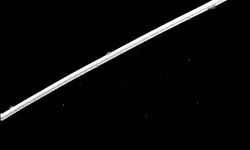
Orbital eccentricity
The orbital eccentricity of an astronomical body is the amount by which its orbit deviates from a perfect circle, where 0 is perfectly circular, and 1.0 is a parabola, and no longer a closed orbit...
of the Uranian rings, it has negligible orbital inclination. The ring's eccentricity causes its brightness to vary over the course of its orbit. The radially integrated brightness of the ε ring is highest near apoapsis and lowest near periapsis. The maximum/minimum brightness ratio is about 2.5–3.0. These variations are connected with the variations of the ring width, which is 19.7 km at the periapsis and 96.4 km at the apoapsis. As the ring becomes wider, the amount of shadowing between particles decreases and more of them come into view, leading to higher integrated brightness. The width variations were measured directly from Voyager 2 images, as the ε ring was one of only two rings resolved by Voyager’s cameras. Such behavior indicates that the ring is not optically thin. Indeed, occultation observations conducted from the ground and the spacecraft showed that its normal optical depth
Optical depth
Optical depth, or optical thickness, is a measure of transparency. Optical depth is defined by the negative logarithm of the fraction of radiation that is not scattered or absorbed on a path...
varies between 0.5 and 2.5, being highest near the periapsis. The equivalent depth of the ε ring is around 47 km and is invariant around the orbit.

Filling factor
Filling factor, ~F~, is a quantity measuring the efficiency of absorption of pump in the core of a double-clad fiber.-Definition:The efficiency of absorption of pumping energy in the fiber is an important parameter of a double-clad fiber laser...
near the apoapsis estimated by different sources at from 0.008 to 0.06. The mean size of the ring particles is 0.2–20.0 m, and the mean separation is around 4.5 times their radius. The ring is almost devoid of dust
Cosmic dust
Cosmic dust is a type of dust composed of particles in space which are a few molecules to 0.1 µm in size. Cosmic dust can be further distinguished by its astronomical location; for example: intergalactic dust, interstellar dust, interplanetary dust and circumplanetary dust .In our own Solar...
, possibly due to the aerodynamic drag from Uranus's extended atmospheric corona. Due to its razor-thin nature the ε ring disappears when viewed edge-on. This happened in 2007 when a ring plane-crossing was observed.
The Voyager 2 spacecraft observed a strange signal from the ε ring during the radio occultation
Radio occultation
Radio occultation is a remote sensing technique used for measuring the physical properties of a planetary atmosphere. It relies on the detection of a change in a radio signal as it passes through the planet's atmosphere i.e. as it is occulted by the atmosphere. When electromagnetic radiation...
experiment. The signal looked like a strong enhancement of the forward-scattering at the wavelength
Wavelength
In physics, the wavelength of a sinusoidal wave is the spatial period of the wave—the distance over which the wave's shape repeats.It is usually determined by considering the distance between consecutive corresponding points of the same phase, such as crests, troughs, or zero crossings, and is a...
3.6 cm near ring’s apoapsis. Such strong scattering requires the existence of a coherent structure. That the ε ring does have such a fine structure has been confirmed by many occultation observations. The ε ring seems to consist of a number of narrow and optically dense ringlets, some of which may have incomplete arcs.
The ε ring is known to have interior and exterior shepherd moons—Cordelia
Cordelia (moon)
Cordelia is the innermost moon of Uranus. It was discovered from the images taken by Voyager 2 on January 20, 1986, and was given the temporary designation S/1986 U 7. It was not detected again until the Hubble Space Telescope observed it in 1997...
and Ophelia
Ophelia (moon)
Ophelia is a moon of Uranus. It was discovered from the images taken by Voyager 2 on January 20, 1986, and was given the temporary designation S/1986 U 8. It was not seen until the Hubble Space Telescope recovered it in 2003. Ophelia was named after the daughter of Polonius, Ophelia, in...
, respectively. The inner edge of the ring is in 24:25 resonance with Cordelia, and the outer edge is in 14:13 resonance
Orbital resonance
In celestial mechanics, an orbital resonance occurs when two orbiting bodies exert a regular, periodic gravitational influence on each other, usually due to their orbital periods being related by a ratio of two small integers. Orbital resonances greatly enhance the mutual gravitational influence of...
with Ophelia. The masses of the moons need to be at least three times the mass of the ring to confine it effectively. The mass of the ε ring is estimated to be about 1016 kg.
δ ring
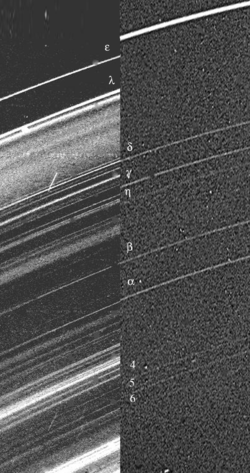
γ ring
The γ ring is narrow, optically dense and slightly eccentric. Its orbital inclination is almost zero. The width of the ring varies in the range 3.6–4.7 km, although equivalent optical depth is constant at 3.3 km. The normal optical depth of the γ ring is 0.7–0.9. During a ring plane-crossing event in 2007 the γ ring disappeared, which means it is geometrically thin like the ε ring and devoid of dust. The width and normal optical depth of the γ ring show significant azimuthal variations. The mechanism of confinement of such a narrow ring is not known, but it has been noticed that the sharp inner edge of the γ ring is in a 6:5 resonance with Ophelia.η ring
The η ring has zero orbital eccentricity and inclination. Like the δ ring, it consists of two components: a narrow optically dense component and a broad outward shoulder with low optical depth. The width of the narrow component is 1.9–2.7 km and the equivalent depth is about 0.42 km, which corresponds to the normal optical depth of about 0.16–0.25. The broad component is about 40 km wide and its equivalent depth is close to 0.85 km, indicating a low normal optical depth of 2 × 10−2. It was resolved in Voyager 2 images. In forward-scattered light, the η ring looked bright, which indicated the presence of a considerable amount of dust in this ring, probably in the broad component. The broad component is much thicker (geometrically) than the narrow one. This conclusion is supported by the observations of a ring plane-crossing event in 2007, when the η ring demonstrated increased brightness, becoming the second brightest feature in the ring system. This is consistent with the behavior of a geometrically thick but simultaneously optically thin ring. Like the majority of other rings, the η ring shows significant azimuthal variations in the normal optical depth and width. The narrow component even vanishes in some places.α and β rings
After the ε ring, the α and β rings are the brightest of Uranus's rings. Like the ε ring, they exhibit regular variations in brightness and width. They are brightest and widest 30° from the apoapsis and dimmest and narrowest 30° from the periapsis. The α and β rings have sizable orbital eccentricity and non-negligible inclination. The widths of these rings are 4.8–10 km and 6.1–11.4 km, respectively. The equivalent optical depths are 3.29 km and 2.14 km, resulting in normal optical depths of 0.3–0.7 and 0.2–0.35, respectively. During a ring plane-crossing event in 2007 the rings disappeared, which means they are geometrically thin like the ε ring and devoid of dust. However, the same event revealed a thick and optically thin dust band just outside the β ring, which was also observed earlier by Voyager 2. The masses of the α and β rings are estimated to be about 5 kg (each)—half the mass of the ε ring.Rings 6, 5 and 4
Rings 6, 5 and 4 are the innermost and dimmest of Uranus's narrow rings. They are the most inclined rings, and their orbital eccentricities are the largest excluding the ε ring. In fact, their inclinations (0.06°, 0.05° and 0.03°) were large enough for Voyager 2 to observe their elevations above the Uranian equatorial plane, which were 24–46 km. Rings 6, 5 and 4 are also the narrowest rings of Uranus, measuring 1.6–2.2 km, 1.9–4.9 km and 2.4–4.4 km wide, respectively. Their equivalent depths are 0.41 km, 0.91 and 0.71 km resulting in normal optical depth 0.18–0.25, 0.18–0.48 and 0.16–0.3. They were not visible during a ring plane-crossing event in 2007 due to their narrowness and lack of dust.λ ring
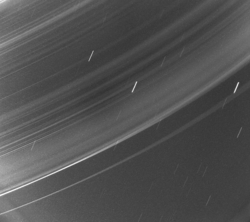
Cordelia (moon)
Cordelia is the innermost moon of Uranus. It was discovered from the images taken by Voyager 2 on January 20, 1986, and was given the temporary designation S/1986 U 7. It was not detected again until the Hubble Space Telescope observed it in 1997...
. This moon clears a dark lane just inside the λ ring. When viewed in back-scattered
Backscatter
In physics, backscatter is the reflection of waves, particles, or signals back to the direction they came from. It is a diffuse reflection due to scattering, as opposed to specular reflection like a mirror...
light, the λ ring is extremely narrow—about 1–2 km—and has the equivalent optical depth 0.1–0.2 km at the wavelength 2.2 μm. The normal optical depth is 0.1–0.2. The optical depth of the λ ring shows strong wavelength dependence, which is atypical for the Uranian ring system. The equivalent depth is as high as 0.36 km in the ultraviolet part of the spectrum, which explains why λ ring was initially detected only in UV stellar occultation
Occultation
An occultation is an event that occurs when one object is hidden by another object that passes between it and the observer. The word is used in astronomy . It can also refer to any situation wherein an object in the foreground blocks from view an object in the background...
s by Voyager 2. The detection during a stellar occultation at the wavelength 2.2 μm was only announced in 1996.
The appearance of the λ ring changed dramatically when it was observed in forward-scattered light in 1986. In this geometry the ring became the brightest feature of the Uranian ring system, outshining the ε ring. This observation, together with the wavelength dependence of the optical depth, indicates that the λ ring contains significant amount of micrometer
Micrometre
A micrometer , is by definition 1×10-6 of a meter .In plain English, it means one-millionth of a meter . Its unit symbol in the International System of Units is μm...
-sized dust. The normal optical depth of this dust is 10−4–10−3. Observations in 2007 by the Keck telescope
Keck telescopes
The W. M. Keck Observatory is a two-telescope astronomical observatory at an elevation of near the summit of Mauna Kea in Hawai'i. The primary mirrors of each of the two telescopes are in diameter, making them the second largest optical telescopes in the world, slightly behind the Gran Telescopio...
during the ring plane-crossing event confirmed this conclusion, because the λ ring became one of the brightest features in the Uranian ring system.
Detailed analysis of the Voyager 2 images revealed azimuthal variations in the brightness of the λ ring. The variations appear to be periodic, resembling a standing wave
Standing wave
In physics, a standing wave – also known as a stationary wave – is a wave that remains in a constant position.This phenomenon can occur because the medium is moving in the opposite direction to the wave, or it can arise in a stationary medium as a result of interference between two waves traveling...
. The origin of this fine structure in the λ ring remains a mystery.
1986U2R/ζ ring
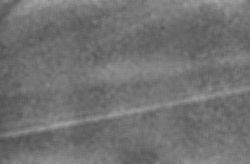
Voyager 2
The Voyager 2 spacecraft is a 722-kilogram space probe launched by NASA on August 20, 1977 to study the outer Solar System and eventually interstellar space...
detected a broad and faint sheet of material inward of ring 6. This ring was given the temporary designation 1986U2R. It had a normal optical depth of 10−3 or less and was extremely faint. It was visible only in a single Voyager 2 image. The ring was located between 37,000 and 39,500 km from the centre of Uranus, or only about 12,000 km above the clouds. It was not observed again until 2003–2004, when the Keck telescope
Keck telescopes
The W. M. Keck Observatory is a two-telescope astronomical observatory at an elevation of near the summit of Mauna Kea in Hawai'i. The primary mirrors of each of the two telescopes are in diameter, making them the second largest optical telescopes in the world, slightly behind the Gran Telescopio...
found a broad and faint sheet of material just inside ring 6. This ring was dubbed the ζ ring. However the position of the recovered ζ ring differs significantly from that observed in 1986. Now it is situated between 37,850 and 41,350 km from the centre of the planet. There is an inward gradually fading extension reaching to at least 32,600 km, or possibly even to 27,000 km—to the atmosphere of Uranus.
The ζ ring was observed again during the ring plane-crossing event in 2007 when it became the brightest feature of the ring system, outshining all other rings combined. The equivalent optical depth of this ring is near 1 km (0.6 km for the inward extension), while the normal optical depth is again less than 10−3. Rather different appearances of the 1986U2R and ζ rings may be caused by different viewing geometries: back-scattering geometry in 2003–2007 and side-scattering geometry in 1986. However, changes during the past 20 years in the distribution of dust, which is thought to predominate in the ring, cannot be ruled out.
Other dust bands
In addition to the 1986U2R/ζ and λ rings, there are other extremely faint dust bands in the Uranian ring system. They are invisible during occultations because they have negligible optical depth, though they are bright in forward-scattered light. Voyager 2s images of forward-scattered light revealed the existence of bright dust bands between the λ and δ rings, between the η and β rings, and between the α ring and ring 4. Many of these bands were detected again in 2003–2004 by the Keck Telescope and during the 2007 ring-plane crossing event in backscattered light, but their precise locations and relative brightnesses were different than during the Voyager observations. The normal optical depth of the dust bands is about 10−5 or less. The dust particle size distribution is thought to obey a power lawPower law
A power law is a special kind of mathematical relationship between two quantities. When the frequency of an event varies as a power of some attribute of that event , the frequency is said to follow a power law. For instance, the number of cities having a certain population size is found to vary...
with the index p = 2.5 ± 0.5.
In addition to separate dust bands the system of Uranian rings appears to be immersed into wide and faint sheet of dust with the normal optical depth not exceeding 10−3.
Outer ring system
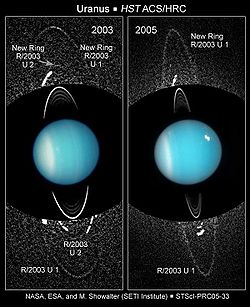
The peak brightness of the μ ring lies almost exactly on the orbit of the small Uranian moon Mab
Mab (moon)
Mab , or Uranus XXVI , is an inner satellite of Uranus. It was discovered by Mark R. Showalter and Jack J. Lissauer in 2003 using the Hubble Space Telescope...
, which is probably the source of the ring’s particles. The ν ring is positioned between Portia
Portia (moon)
Portia is an inner satellite of Uranus. It was discovered from the images taken by Voyager 2 on 3 January 1986, and was given the temporary designation S/1986 U 1. The moon is named after Portia, the heroine of William Shakespeare's play The Merchant of Venice...
and Rosalind
Rosalind (moon)
Rosalind is an inner satellite of Uranus. It was discovered from the images taken by Voyager 2 on 13 January 1986, and was given the temporary designation S/1986 U 4. It was named after the daughter of the banished Duke in William Shakespeare's play As You Like It...
and does not contain any moons inside it. A reanalysis of the Voyager 2 images of forward-scattered light clearly reveals the μ and ν rings. In this geometry the rings are much brighter, which indicates that they contain much micrometer-sized dust. The outer rings of Uranus may be similar to the G and E rings of Saturn. The G ring also lacks any observable source bodies, while the E ring is extremely broad and receives dust from Enceladus
Enceladus (moon)
Enceladus is the sixth-largest of the moons of Saturn. It was discovered in 1789 by William Herschel. Until the two Voyager spacecraft passed near it in the early 1980s very little was known about this small moon besides the identification of water ice on its surface...
.
The μ ring may consist entirely of dust, without any large particles at all. This hypothesis is supported by observations performed by the Keck telescope, which failed to detect the μ ring in the near infrared at 2.2 μm, but detected the ν ring. This failure means that the μ ring is blue in color, which in turn indicates that very small (submicrometer) dust predominates within it. The dust may be made of water ice. In contrast, the ν ring is slightly red in color.
Dynamics and origin
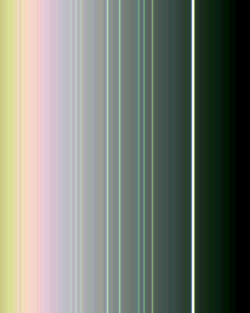
Peter Goldreich
Peter Goldreich is an American astrophysicist whose research focuses on celestial mechanics, planetary rings, helioseismology and neutron stars. He is currently the Lee DuBridge Professor of Astrophysics and Planetary Physics at California Institute of Technology. Since 2005 he has also been a...
and Tremaine
Scott Tremaine
Scott Duncan Tremaine is a Canadian-born astrophysicist. He is a fellow of the Royal Society of London, the Royal Society of Canada and the National Academy of Sciences. Tremaine is widely regarded as one of the world's leading astrophysicists for his contributions to the theory of solar system...
, is that a pair of nearby moons, outer and inner shepherds, interact gravitationally with a ring and act like sinks and donors, respectively, for excessive and insufficient angular momentum (or equivalently, energy). The shepherds thus keep ring particles in place, but gradually move away from the ring themselves. To be effective, the masses of the shepherds should exceed the mass of the ring by at least a factor of two to three. This mechanism is known to be at work in the case of the ε ring, where Cordelia
Cordelia (moon)
Cordelia is the innermost moon of Uranus. It was discovered from the images taken by Voyager 2 on January 20, 1986, and was given the temporary designation S/1986 U 7. It was not detected again until the Hubble Space Telescope observed it in 1997...
and Ophelia
Ophelia (moon)
Ophelia is a moon of Uranus. It was discovered from the images taken by Voyager 2 on January 20, 1986, and was given the temporary designation S/1986 U 8. It was not seen until the Hubble Space Telescope recovered it in 2003. Ophelia was named after the daughter of Polonius, Ophelia, in...
serve as shepherds. Cordelia is also the outer shepherd of the δ ring, and Ophelia is the outer shepherd of the γ ring. However no moon larger than 10 km is known in the vicinity of other rings. The current distance of Cordelia and Ophelia from the ε ring can be used to estimate the ring’s age. The calculations show that the ε ring cannot be older than 6 × 108 years.
Since the rings of Uranus appear to be young, they must be continuously renewed by the collisional fragmentation of larger bodies. The estimates show that the lifetime against collisional disruption of a moon with the size like that of Puck
Puck (moon)
Puck is an inner moon of Uranus. It was discovered in December 1985 by the Voyager 2 spacecraft. The name Puck comes from Celtic mythology and English folklore. The orbit of Puck lies between the rings of Uranus and the first of Uranus' large moons, Miranda. Puck is approximately spherical in...
is a few billion years. The lifetime of a smaller satellite is much shorter. Therefore all current inner moons and rings can be products of disruption of several Puck-sized satellites during the last four and half billion years. Every such disruption would have started a collisional cascade that quickly ground almost all large bodies into much smaller particles, including dust. Eventually the majority of mass was lost, and particles survived only in positions that were stabilized by mutual resonances and shepherding. The end product of such a disruptive evolution would be a system of narrow rings. However, a few moonlet
Moonlet
Moonlet is an informal term for a particularly small natural satellite. In astronomical literature, it has been used in at least two situations:...
s must still be embedded within the rings at present. The maximum size of such moonlets is probably around 10 km.
The origin of the dust
Dust
Dust consists of particles in the atmosphere that arise from various sources such as soil dust lifted up by wind , volcanic eruptions, and pollution...
bands is less problematic. The dust has a very short lifetime, 100–1000 years, and should be continuously replenished by collisions between larger ring particles, moonlets and meteoroid
Meteoroid
A meteoroid is a sand- to boulder-sized particle of debris in the Solar System. The visible path of a meteoroid that enters Earth's atmosphere is called a meteor, or colloquially a shooting star or falling star. If a meteoroid reaches the ground and survives impact, then it is called a meteorite...
s from outside the Uranian system. The belts of the parent moonlets and particles are themselves invisible due to their low optical depth, while the dust reveals itself in forward-scattered light. The narrow main rings and the moonlet belts that create dust bands are expected to differ in particle size distribution. The main rings have more centimeter to meter-sized bodies. Such a distribution increases the surface area of the material in the rings, leading to high optical density in back-scattered light. In contrast, the dust bands have relatively few large particles, which results in low optical depth.
Exploration
The rings were thoroughly investigated during the Voyager 2Voyager 2
The Voyager 2 spacecraft is a 722-kilogram space probe launched by NASA on August 20, 1977 to study the outer Solar System and eventually interstellar space...
spacecraft's flyby of Uranus in January 1986. Two new faint rings—λ and 1986U2R—were discovered bringing the total number then known to eleven. Rings were studied by analysing results of radio, ultraviolet and optical occultations. Voyager 2 observed the rings in different geometries relative to the sun, producing images with back-scattered, forward-scattered and side-scattered light. Analysis of these images allowed derivation of the complete phase function, geometrical and Bond albedo of ring particles. Two rings—ε and η—were resolved in the images revealing a complicated fine structure. Analysis of Voyager's images also led to discovery of 10 inner moons of Uranus, including the two shepherd moons of the ε ring—Cordelia and Ophelia.
List of properties
This table summarizes the properties of the planetary ringPlanetary ring
A planetary ring is a ring of cosmic dust and other small particles orbiting around a planet in a flat disc-shaped region.The most notable planetary rings known in Earth's solar system are those around Saturn, but the other three gas giants of the solar system possess ring systems of their...
system of Uranus
Uranus
Uranus is the seventh planet from the Sun. It has the third-largest planetary radius and fourth-largest planetary mass in the Solar System. It is named after the ancient Greek deity of the sky Uranus , the father of Cronus and grandfather of Zeus...
.
| Ring name | Radius (km) | Width (km) | Eq. depth (km) | N. Opt. depth | Thickness (m) | Ecc. | Incl.(°) | Notes |
| ζcc | 26 840–34 890 | 8 000 | 0.8 | ~ 10−4 | ? | ? | ? | Inward extension of the ζc ring |
| ζc | 34 890–37 850 | 3 000 | 0.6 | ~ 10−3 | ? | ? | ? | Inward extension of the ζ ring |
| 1986U2R | 37 000–39 500 | 2 500 | <2.5 | < 10−3 | ? | ? | ? | Faint dusty ring |
| ζ | 37 850–41 350 | 3 500 | 1 | ~ 10−3 | ? | ? | ? | |
| 6 | 41 837 | 1.6–2.2 | 0.41 | 0.18–0.25 | ? | 1.0 × 10−3 | 0.062 | |
| 5 | 42 234 | 1.9–4.9 | 0.91 | 0.18–0.48 | ? | 1.9 × 10−3 | 0.054 | |
| 4 | 42 570 | 2.4–4.4 | 0.71 | 0.16–0.30 | ? | 1.1 × 10−3 | 0.032 | |
| α | 44 718 | 4.8–10.0 | 3.39 | 0.3–0.7 | ? | 0.8 × 10−3 | 0.015 | |
| β | 45 661 | 6.1–11.4 | 2.14 | 0.20–0.35 | ? | 0.4 × 10−3 | 0.005 | |
| η | 47 175 | 1.9–2.7 | 0.42 | 0.16–0.25 | ? | 0 | 0.001 | |
| ηc | 47 176 | 40 | 0.85 | 2 × 10−2 | ? | 0 | 0.001 | Outward broad component of the η ring |
| γ | 47 627 | 3.6–4.7 | 3.3 | 0.7–0.9 | 150? | 0.1 × 10−3 | 0.002 | |
| δc | 48 300 | 10–12 | 0.3 | 3 × 10−2 | ? | 0 | 0.001 | Inward broad component of the δ ring |
| δ | 48 300 | 4.1–6.1 | 2.2 | 0.3–0.6 | ? | 0 | 0.001 | |
| λ | 50 023 | 1–2 | 0.2 | 0.1–0.2 | ? | 0? | 0? | Faint dusty ring |
| ε | 51 149 | 19.7–96.4 | 47 | 0.5–2.5 | 150? | 7.9 × 10−3 | 0 | Shepherded by Cordelia Cordelia (moon) Cordelia is the innermost moon of Uranus. It was discovered from the images taken by Voyager 2 on January 20, 1986, and was given the temporary designation S/1986 U 7. It was not detected again until the Hubble Space Telescope observed it in 1997... and Ophelia Ophelia (moon) Ophelia is a moon of Uranus. It was discovered from the images taken by Voyager 2 on January 20, 1986, and was given the temporary designation S/1986 U 8. It was not seen until the Hubble Space Telescope recovered it in 2003. Ophelia was named after the daughter of Polonius, Ophelia, in... |
| ν | 66 100–69 900 | 3 800 | 0.012 | 5.4 × 10−6 | ? | ? | ? | Between Portia Portia (moon) Portia is an inner satellite of Uranus. It was discovered from the images taken by Voyager 2 on 3 January 1986, and was given the temporary designation S/1986 U 1. The moon is named after Portia, the heroine of William Shakespeare's play The Merchant of Venice... and Rosalind Rosalind (moon) Rosalind is an inner satellite of Uranus. It was discovered from the images taken by Voyager 2 on 13 January 1986, and was given the temporary designation S/1986 U 4. It was named after the daughter of the banished Duke in William Shakespeare's play As You Like It... , peak brightness at 67 300 km |
| μ | 86 000–103 000 | 17 000 | 0.14 | 8.5 × 10−6 | ? | ? | ? | At Mab Mab (moon) Mab , or Uranus XXVI , is an inner satellite of Uranus. It was discovered by Mark R. Showalter and Jack J. Lissauer in 2003 using the Hubble Space Telescope... , peak brightness at 97 700 km |
External links
- Uranus' Rings by NASA's Solar System Exploration
- Uranus Rings Fact Sheet
- Hubble Discovers Giant Rings and New Moons Encircling Uranus – Hubble Space Telescope news release (22 December 2005)
- Gazeteer of Planetary Nomenclature - Ring and Ring Gap Nomenclature (Uranus), USGS

